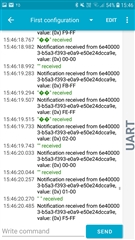Hi,
I merge saadc and ble_uart together in order to send send sensor output(now just analog voltage) to mobile app. I want to check weather the ADC is working properly or not. Digital values for same voltage are very different from each other and it seems changing voltage does have impact on digital value. How can I check adc's functionality?
Best regards,
Kosar



